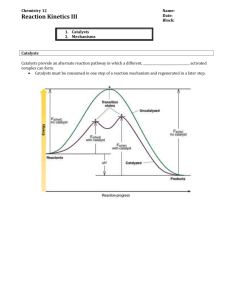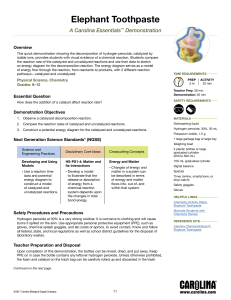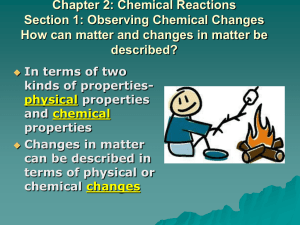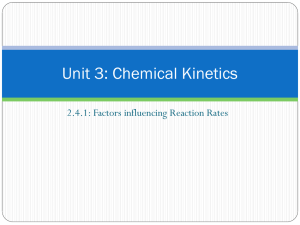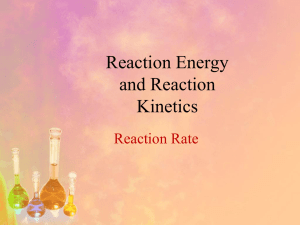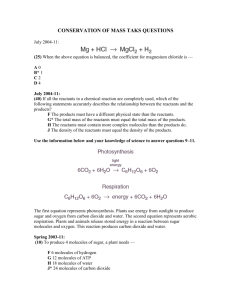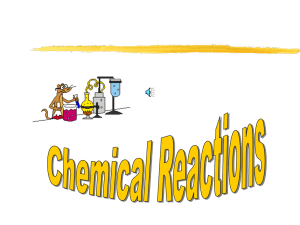Reaction Mechanisms notes - Westgate Mennonite Collegiate
advertisement
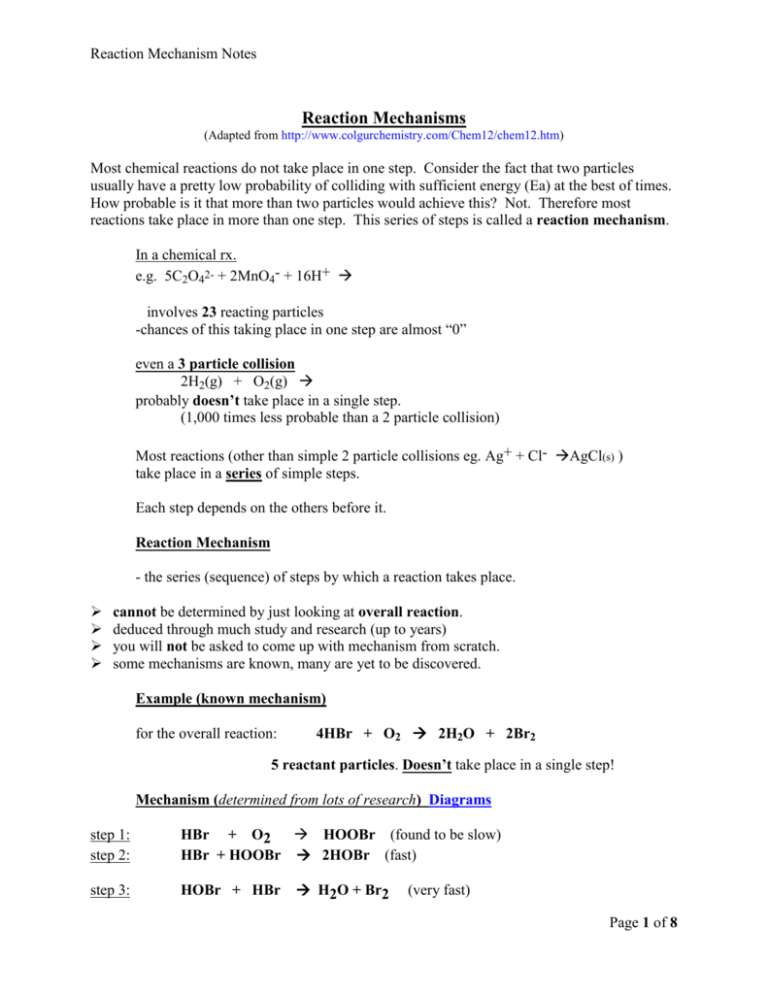
Reaction Mechanism Notes Reaction Mechanisms (Adapted from http://www.colgurchemistry.com/Chem12/chem12.htm) Most chemical reactions do not take place in one step. Consider the fact that two particles usually have a pretty low probability of colliding with sufficient energy (Ea) at the best of times. How probable is it that more than two particles would achieve this? Not. Therefore most reactions take place in more than one step. This series of steps is called a reaction mechanism. In a chemical rx. e.g. 5C2O42- + 2MnO4- + 16H+ involves 23 reacting particles -chances of this taking place in one step are almost “0” even a 3 particle collision 2H2(g) + O2(g) probably doesn’t take place in a single step. (1,000 times less probable than a 2 particle collision) Most reactions (other than simple 2 particle collisions eg. Ag+ + Cl- AgCl(s) ) take place in a series of simple steps. Each step depends on the others before it. Reaction Mechanism - the series (sequence) of steps by which a reaction takes place. cannot be determined by just looking at overall reaction. deduced through much study and research (up to years) you will not be asked to come up with mechanism from scratch. some mechanisms are known, many are yet to be discovered. Example (known mechanism) for the overall reaction: 4HBr + O2 2H2O + 2Br2 5 reactant particles. Doesn’t take place in a single step! Mechanism (determined from lots of research) Diagrams step 1: step 2: HBr + O2 HOOBr (found to be slow) HBr + HOOBr 2HOBr (fast) step 3: HOBr + HBr H2O + Br2 (very fast) Page 1 of 8 Reaction Mechanism Notes - Each step is called an Elementary Process Rate determining step - the slowest step in the mechanism. the overall reaction can never be faster than the RDS the only way to speed up an overall reaction is to speed up the RDS (eg. by increasing. the concentration of a reactant in the RDS) eg.) in this case, increasing [HBr] or [O2] would speed up Step 1 (the RDS) and hence the overall rate. - speeding up a fast step (not RDS) will have no effect on the overall rate. (eg. adding HOOBr or HOBr has no effect) Determining overall reaction given steps (mechanism) - cancel stuff which is identical on both sides - add up what’s left. eg.) 1.) 2.) 3.) HBr + O2 HOOBr HBr + HOOBr 2HOBr 2HBr + 2HOBr 2H2O + 2Br2 _____________________________________________________________________ 4HBr + O2 2H2O + 2Br2 _____________________________________________________________________ overall rx: eg.) 1.) 2.) 3.) A + 2X AX2 AX2 + X AX + X2 AX + A A2 + X _____________________________________________________________________ overall rx:____________________________________________ Question the following reaction occurs in a 3 step mechanism: 2A4+ + B+ 2A3+ + B3+ this is the overall reaction step 1: A4+ + C2+ C3+ + A3+ step 2: A4+ + C3+ C4+ + A3+ step 3: ? find step 3. Page 2 of 8 Reaction Mechanism Notes Another Example: Consider the following reaction for the formation of HCl in the presence of light. Cl2 + CHCl3 HCl + CCl4 The following is the proposed reaction mechanism: Step 1: Cl2 Cl + Cl Step 2: Step 3: Cl + CCl3 CCl4 Determine Step 2 of the reaction mechanism. Step 2: ________________________________________________________ Reaction intermediate -a species (atom, molecule or ion) which is produced in one step and used up in a later step. (appears on right & also lower on left) eg.) 1) 2) 3) For the mechanism: HBr + O2 HOOBr HBr + HOOBr 2HOBr 2HBr + 2HOBr 2H2O + 2Br2 intermediates are ___ & ______________ Notes: an intermediate doesn’t accumulate (like a product) because as soon as it is formed, it gets used up again (like money) intermediates are not necessarily unstable. (in other circumstances, they may last a while) an activated complex is very unstable and short-lived. It doesn’t usually obey bonding “rules”. Page 3 of 8 Reaction Mechanism Notes PE diagram for a reaction mechanism AC (step 1) AC (step 2) AC (step 3) HOOBr PE HOBr HBr + O2 STEP 1 STEP 2 STEP 3 H2O + Br2 REACTION PROCEEDS Notes: each “bump” is a step the higher the bump, (greater Ea) the slower the step the highest bump (from the reactants level) is for the RDS AC’s at top of bumps, intermediates in middle “valleys”, products in the final “valley” the Ea for the forward overall rx. is vertical distance from reactants to top of highest bump. On the diagram for this mechanism on the previous page, label the Rate Determining Step. Draw an arrow to show the Ea (overall reaction) . Label it. Draw another labeled arrow to show the Ea for Step 1. Draw a labeled arrow to show for the overall reaction. P E Ea (Overall Rx.) REACTION PROCEEDS P E Ea (Overall Rx.) REACTION PROCEEDS Page 4 of 8 Reaction Mechanism Notes In each of the reactions in the previous diagrams, the Ea for the overall forward reaction is the difference in energy between the reactants and the top of the highest peak. Question: Given the following Potential Energy Diagram for a reaction mechanism: PE (KJ) 80 70 60 50 Reaction Proceeds 1. This mechanism has 3. Step steps 2. Ea for overall rx = is the RDS 4. Step 5. The overall rx. is 7. for reverse rx. = kJ is the fastest step. thermic 6. = kJ 8. Ea (reverse rx.) = kJ kJ 9. RDS for reverse rx. is step Draw a Potential Energy Diagram for a reaction mechanism with 2 steps. The first step is fast and the second step is slow. The overall reaction is exothermic. With labeled arrows show the overall Activation Energy (Ea) and the for the forward reaction. PE Page 5 of 8 Reaction Proceeds Reaction Mechanism Notes How catalysts work - “to avoid a hill, build a “ catalyst- an introduced substance which produce an alternate mechanism with a lower activation energy. PE DIAGRAM SHOWING ONLY THE UNCATALYZED REACTION 2 00 PE 18 0 (kJ) 16 0 14 0 12 0 10 0 80 60 REACTANTS 40 PRODUCTS 20 Progress of Reaction Look on the next page to see the PE diagram showing the uncatalyzed and the catalyzed “routes” for the same reaction…. PE DIAGRAM SHOWING THE UNCATALYZED AND THE CATALYZED REACTION 200 PE 180 (kJ 160 ) 140 120 Ea (uncatalyzed rx.) 100 Catalyzed Ea (catalyzed rx.) 80 60 Uncatalyzed route REACTANTS Page 6 of 8 40 PRODUCTS 20 Progress of Reaction Reaction Mechanism Notes Notes energy required (Ea) is less with the catalyst, so at the same temperature, more molecules can make it over the “barrier” so reaction rate speeds up (eg. lower standards for a pass, eg. 30% will let more students pass!) catalyzed reactions usually involve more steps but it’s highest Ea (highest bump) is never as high as the uncatalyzed reaction a catalyst NEVER changes the PE of reactants of products - only the route between them. (no change in ) uncatalyzed reaction still continues at its own slow rate when a catalyst is added. (usually insignificant compared to catalyzed rate) if catalyst speeds up forward reaction, it also speeds up (reduces Ea for) the reverse reaction. Study the PE diagram on the next page which compares the Ea’s for the forward and reverse uncatalyzed and catalyzed reactions… PE DIAGRAM SHOWING THE UNCATALYZED AND THE CATALYZED REACTIONS 2 00 PE 18 0 (kJ) 16 0 14 0 Ea(f) (uncatalyzed ) 12 0 Uncatalyzed route Catalyzed route 10 0 Ea(f) (catalyzed) Ea (r) (Uncatalyzed ) 80 60 REACTANTS 40 PRODUCTS 20 Progress of Reaction Ea (r) Page 7 (Catalyzed ) of 8 Reaction Mechanism Notes Catalysts sometimes work by... http://www.chem.iastate.edu/group/Greenbowe/sections/projectfolder/animations/Catalyst2NOO2N28.html providing a surface whose spacing of atoms is just right to break a reactant molecule and hold it for an attack from another reactant. helping to form an intermediate which can react more easily to form products. eg.) 2H2O2(l) 2H2O(l) + O2(g) (very slow uncatalyzed) -add some KI (I-) LET’S TRY IT! Catalyzed Mechanism: step 1) H2O2 + I- ---> H2O + OI- (The catalyst I- is put in.) step 2) H2O2 + OI- ---> H2O + O2 + I- (The catalyst I- is regenerated.) overall rx. 2H2O2 ---> 2H2O + O2 Page 8 of 8
